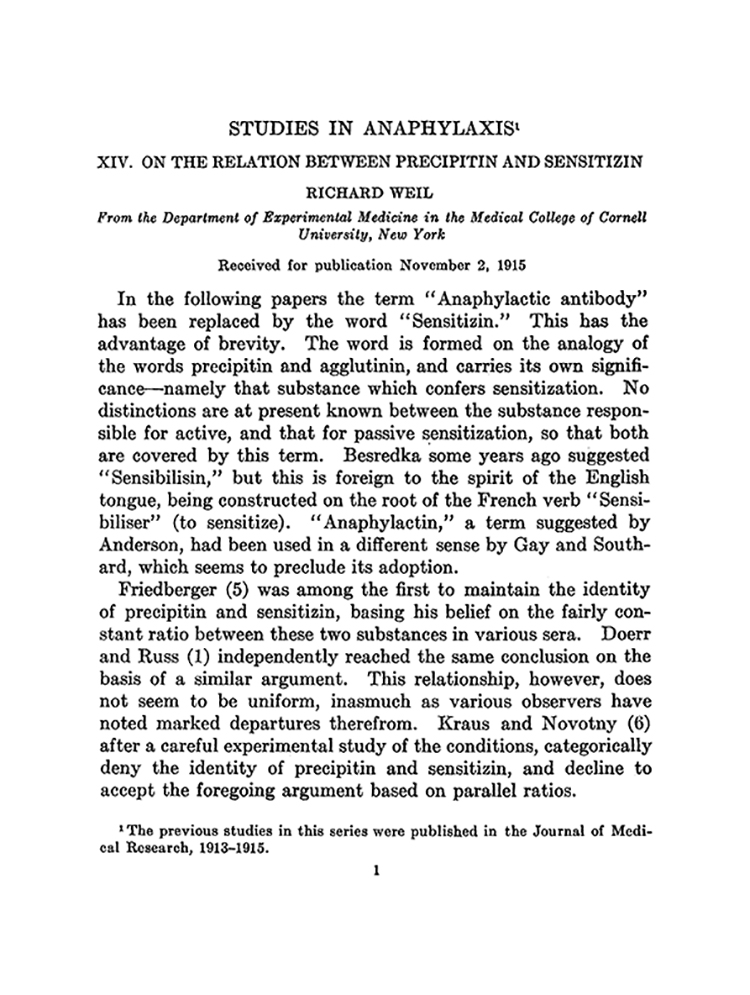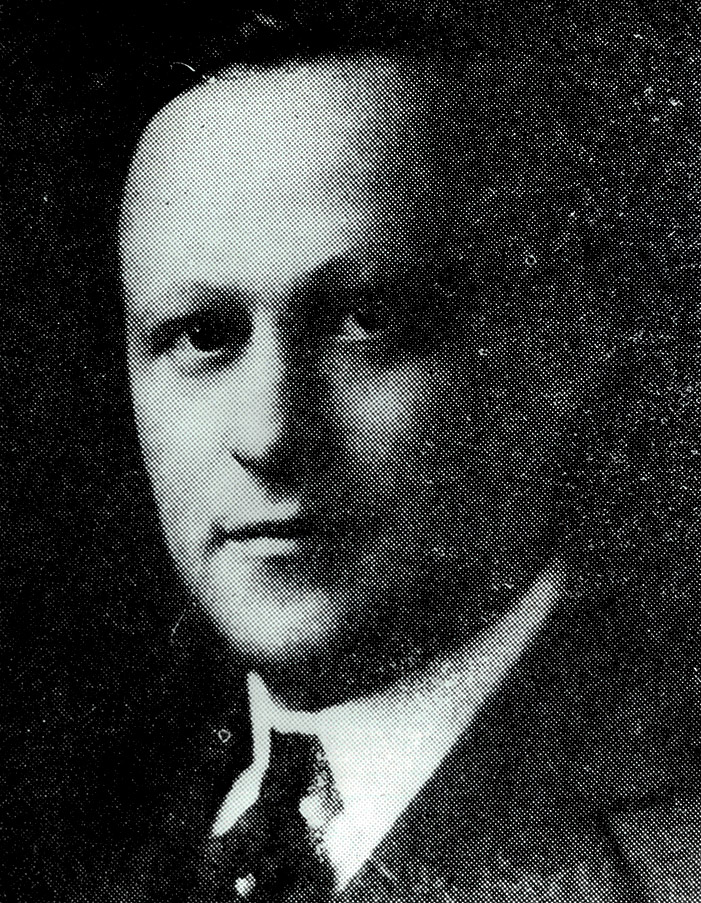History of The JI
“Studies in Anaphylaxis”—The First Article in The JI
by Mary Litzinger
December 2011, page 18
In February 1916, The American Association of Immunologists (AAI) and the New York Society for Serology and Hematology (SSH) jointly published the first issue of The Journal of Immunology. (See “The Founding of The Journal of Immunology”) The goal for the new journal was to advance the field of immunology, already recognized to be vital to understanding and treating disease, by publishing the newest research in “immunity, serology, and bacterial therapy” and discussing the “problems of immunology.” With these aims in mind, the editors chose for the first article a study on a major immunological debate of the day, the mechanism of anaphylaxis.
 “Studies in Anaphylaxis” by Richard Weil
“Studies in Anaphylaxis” by Richard Weil
The Journal of ImmunologyThe article was “XIV. Studies in Anaphylaxis: On the Relation between Precipitin and Sensitizin” by Richard Weil (AAI ’14, president 1916–17), chair of Department of Experimental Medicine, Cornell Medical College. The article is of interest for more than just its scientific content as it also demonstrates the scientific milieu and conventions of the time. Weil was well placed to publish his paper, for he was a founding member and future president of AAI and also a member of the SSH. Unlike most modern research papers, his article had only a single author, lacked defined Abstract, Methods, Results, and Discussion sections, and was written in an almost conversational style. Further, the article was the 14th in a series, with the first 13 published in the Journal of Medical Research—the 15th, 16th, and 17th (the final) in the series were published simultaneously with the 14th in The JI. In this first article in The JI, and throughout his larger series of articles, Weil persuasively argued for a cellular mechanism of anaphylaxis.
Although the phenomenon of anaphylaxis had been described earlier, the seminal experiments were reported by Charles Richet and Paul Portier in 1902. In attempting to vaccinate experimental animals including pigeons and dogs against the toxin of the Portuguese man-of-war or, later, sea anemones, they were shocked to note the opposite effect. The animals injected with a second vaccinating dose became violently ill and died. Richet and Portier created a new term for this observed hypersensitivity: “anaphylaxis,” which literally means “against protection.” Following previous demonstrations of natural and artificially induced immunity to infection, the description of anaphylaxis was the first comprehensive demonstration of harmful effects caused by the immune system. This discovery changed the conception of immunology and earned Richet the Nobel Prize in Physiology or Medicine in 1913.
By the time of the publication of Weil’s article in The JI, scientists were divided in their views on whether the cause of anaphylaxis was humoral or cellular—a divide firmly entrenched in early immunology itself. While both sides agreed that interaction between antigen and antibody caused anaphylaxis, proponents of the humoral theory asserted that antigen and antibody combined in the blood to form a chemical toxin. In his Nobel address, Richet touched upon this idea as a simple explanation for the ‘toxin’ produced by in vitro incubation of immune serum and antigen. He explained that “there exists in anaphylactized blood a substance harmless in itself but which releases a strong poison when mixed with the antigen.”
 Richard Weil
Richard Weil
AAI Collection, UMBCIn Weil’s article, he described how, through a series of injections of immune rabbit serum and horse serum into guinea pigs, he concluded that “precipitating antibody” and “sensitizing antibody” (i.e., antibody responsible for anaphylaxis) were identical. (Interestingly, by studying the guinea pig as a model, he primarily would have been describing IgG1, rather than the classic IgE.) He further stated that the precipitating function of the antibody could be destroyed (by heat or chemical treatment) without affecting the sensitizing value, presuming this to be due to the retained antigen-binding capacity of the antibody. In his concluding statements, Weil firmly asserted his belief regarding the mechanism of anaphylaxis: “Anaphylaxis therefore consists simply in the cellular reaction due to the fixation of antigen by cellular antibody.”
Of course, we know today that Weil would ultimately be proven correct in his cellular theory of anaphylaxis. The discovery of IgE in the 1960s spurred impressive progress in the field. It is now well established that antigen crosslinking of IgE on mast cells and/or basophils triggers their degranulation to induce anaphylaxis and that prompt treatment with epinephrine reverses the life-threatening effects. Nevertheless, the frequency of anaphylaxis seems to be increasing, and patients look toward current researchers for new solutions. A century following the experiments of Richet and Weil, investigators continue to shed light on signaling events which occur during anaphylaxis, identifying potential new therapeutic targets.
From its launch in February 1916, The JI was intended to advance the field of immunology as a whole. But the editors of the journal and, by extension, the members of AAI also wanted to represent the contributions of preeminent scientists in the U.S. and England in particular. Given their attempt to define themselves as a group, their choice of the first article was perhaps not so surprising. The publication of Weil’s article placed The JI on one side of a hotly debated issue, ensuring the relevance of the journal to the field and positioning the young society as an emerging forum for discussion and dissemination of discoveries advancing immunology.
References
- Portier, Paul and Charles Richet. “De l’action anaphylactique de certains venins.” Comptes rendus des séances de la Société de biologie et de ses filiales 54 (1902): 170–172.
- Richet, Charles. “The Nobel Prize in Physiology or Medicine 1913—Award Ceremony Speech,” Nobelprize.org (accessed October 26, 2017).
- Weil, Richard. “Anaphylatoxin and the mechanism of anaphylaxis.” In Proceedings of the Second Pan American Scientific Congress 10, sec 8, part 2. Edited by Glen Levin Swiggett. Washington, DC: Gov. Print. Off., 1916.
- Weil, Richard, “Studies in anaphylaxis. XIV. On the relation between precipitin and sensitizin,” The Journal of Immunology 1, no. 1 (1916): 1–18.
- Announcement. The Journal of Immunology 1, no. 1 (1916).